![]()
During the tumultuous years of World War II, communication between American soldiers overseas and their loved ones back home was not just a matter of personal comfort but a crucial element in maintaining morale on the front lines. Letters served as lifelines, offering soldiers a connection to normalcy and a respite from the horrors of war. Yet, amidst vast oceans and war-torn landscapes, the logistical challenges of transporting millions of letters were immense. Enter Victory Mail, or V-Mail: a revolutionary system that leveraged cutting-edge microfilm technology to streamline correspondence during the war.
Origins and Necessity of V-Mail
The global scale of World War II presented unprecedented communication challenges. Traditional mail services were overwhelmed by the sheer volume of letters that needed to traverse continents and oceans under perilous conditions. Ships and aircraft were prioritized for transporting troops, weapons, and essential supplies, leaving limited space for mail. Additionally, the risk of mail being lost or delayed due to enemy action was ever-present. By mid-war, millions of letters were sent monthly, creating a logistical burden that traditional systems could not sustain.
![]()
The psychological importance of communication cannot be overstated. Letters from home provided soldiers with comfort, emotional support, and a sense of purpose. For families, hearing from their loved ones in active service was a source of immense reassurance. Recognizing the critical nature of this connection, the U.S. government sought a solution that would alleviate the logistical strain while maintaining reliable delivery.
![]()
The solution lay in adapting and refining a technology pioneered by the British. The “Airgraph” system, introduced in 1941, used microphotography to condense the physical bulk of letters, facilitating easier transportation by air. Inspired by its success, the United States developed its version: Victory Mail.
In June 1942, the U.S. Army officially launched the V-Mail service in collaboration with Eastman Kodak Company and other technological partners. At its core was microfilm—a medium capable of storing reduced images of documents. This innovation condensed thousands of letters onto small, lightweight rolls that could be transported with minimal resource use.
![]()
The V-Mail system represented a harmonious blend of necessity and ingenuity. Microfilm technology had existed since the early 20th century, but its application to personal correspondence during wartime showcased its transformative potential. The success of V-Mail was rooted not just in its technological sophistication but also in the careful coordination between military logistics and postal services.
Technical Aspects of V-Mail
The Process of Writing and Sending V-Mail
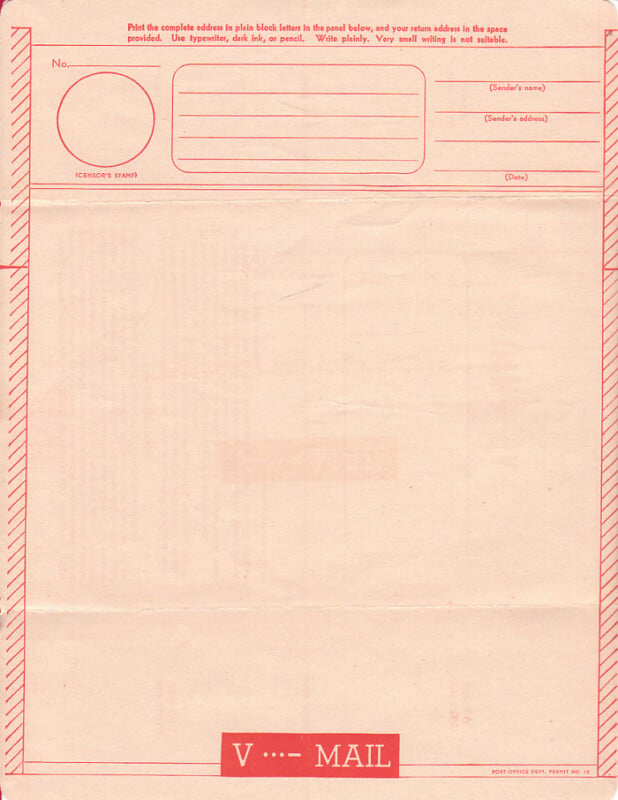 A blank V-Mail form
A blank V-Mail formV-Mail relied on standardized letter sheets measuring approximately seven by nine inches. These sheets included designated spaces for the sender’s and recipient’s addresses, a section for censor markings, and an area for the message itself. The format ensured uniformity, which was critical for efficient processing.
Once written, letters underwent censorship — a wartime necessity to prevent sensitive information from falling into enemy hands. After passing this stage, letters proceeded to microfilming.
Microfilming Process
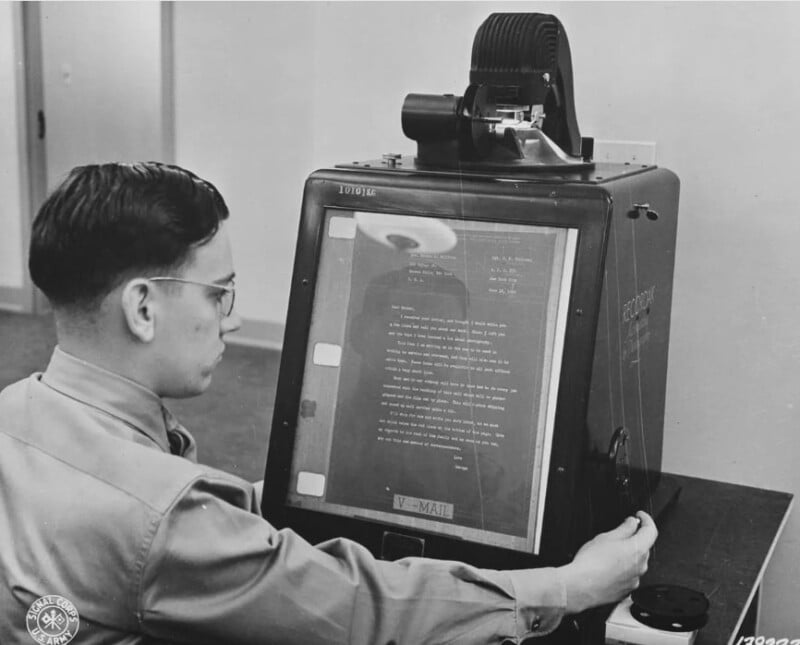 Inspecting V-Mail for flaws
Inspecting V-Mail for flawsThe heart of V-Mail’s efficiency lay in the microfilming process. High-resolution cameras photographed each letter, reducing its size to fit a 16mm microfilm frame. This technology was nothing short of revolutionary: a single roll of microfilm could store approximately 1,600 letters and weighed just a few ounces. In contrast, the equivalent paper letters would weigh hundreds of pounds.
The cameras used for this process, such as Eastman Kodak’s Recordak models, were designed for high-speed operation, capable of photographing thousands of documents per hour. This efficiency was vital in keeping pace with the vast volume of wartime correspondence.
Transportation and Reproduction
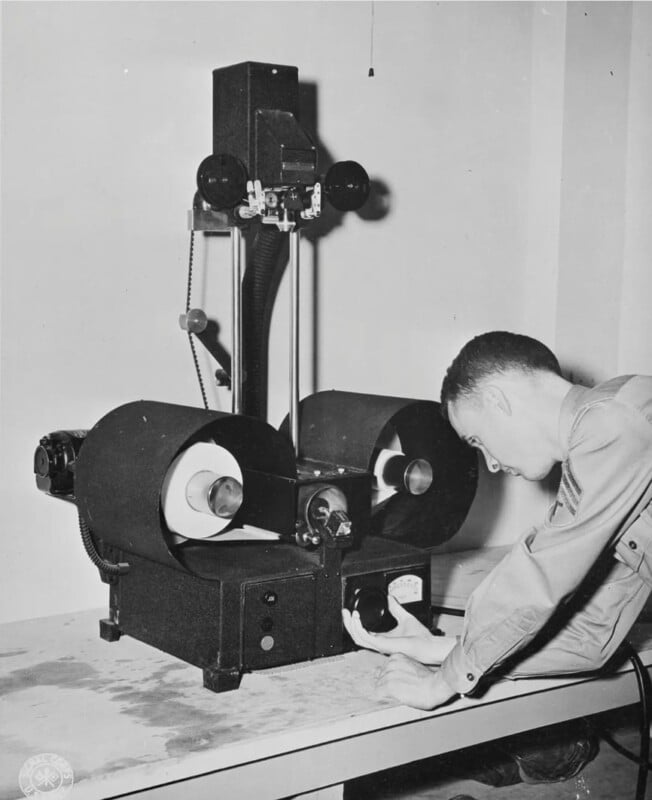 V-Mail letters printed with an enlarger
V-Mail letters printed with an enlarger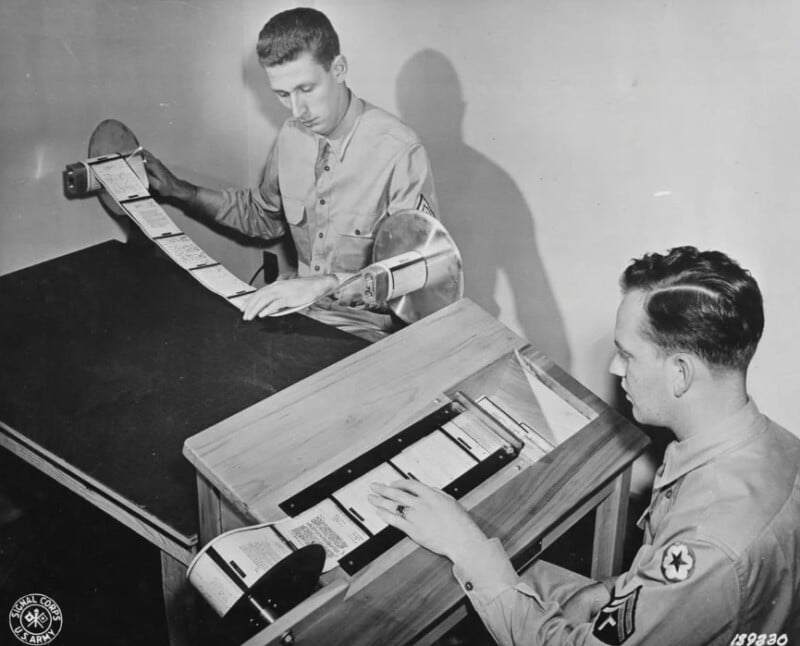 V-Mail letters inspected and cut into individual letters
V-Mail letters inspected and cut into individual lettersOnce microfilmed, the rolls were transported by air or sea to destination processing centers. Upon arrival, the letters were reproduced onto photographic paper. The reproduced images, measuring approximately 4.25 by 5 inches, were smaller than the originals but remained legible. These were then cut, placed into envelopes, and delivered to recipients through standard postal services.
Reduction of Weight and Volume
![]()
The logistical advantages of V-Mail were profound. By reducing the physical space and weight required for correspondence, V-Mail saved an estimated 98% in cargo space compared to traditional mail. For example, 150,000 one-page letters would typically weigh over a ton; on microfilm, they weighed a mere 45 pounds. This efficiency freed up critical transportation resources for military supplies and personnel.
Equipment Used
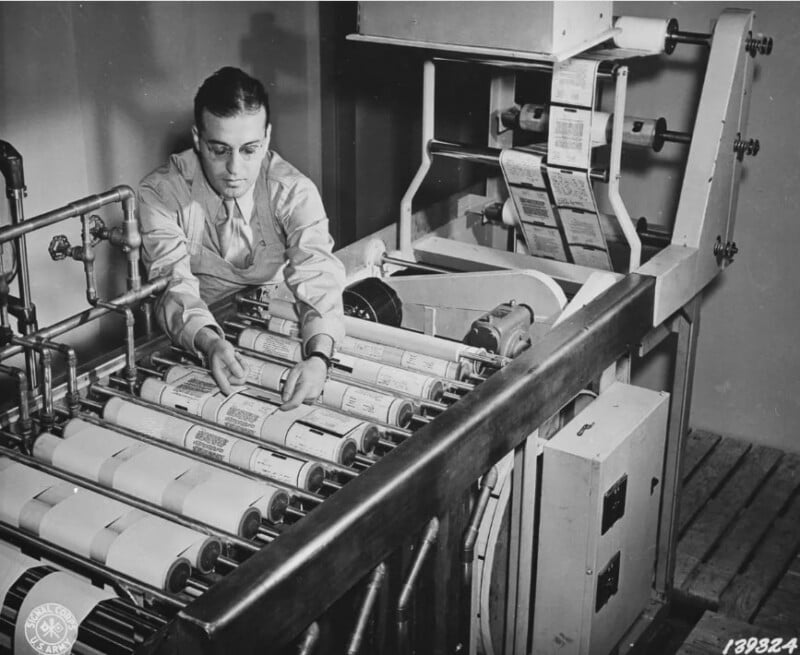 Paper processing machine
Paper processing machineThe technical implementation of V-Mail required specialized equipment, including:
- Microfilm Cameras: Devices like the Recordak cameras, developed by Eastman Kodak, were used for high-speed microfilming.
- Processing Laboratories: Facilities equipped with developing machines to process the microfilm negatives into positive prints upon arrival.
- Reproduction Equipment: Enlargers and printers to produce readable copies of the letters from the microfilm.
 Kodak Recordak machine
Kodak Recordak machineImpact and Usage
![]()
From 1942 to 1945, V-Mail became a cornerstone of wartime communication, processing over a billion letters. Its impact extended beyond logistical efficiency; it played a vital role in maintaining morale on both the front lines and the home front.
The efficiency of V-Mail significantly eased the burden on military transportation networks. This was especially critical in the European and Pacific theaters, where supply lines were stretched across vast distances. By minimizing the space and weight of mail, V-Mail ensured that correspondence did not compete with essential military shipments.
![]()
Despite its standardized format and reduced size, V-Mail was widely embraced. Soldiers valued the assurance of delivery and the relatively quick turnaround compared to traditional mail. Families appreciated the ability to maintain regular contact with their loved ones, even if the letters lacked the personal touch of handwritten notes or enclosed items.
As mentioned, censorship was integral to the V-Mail process. Each letter was reviewed to ensure that sensitive information — such as troop movements or military plans — was not disclosed. The microfilming process added another layer of security, as miniature images were less susceptible to interception and tampering.
![]()
While V-Mail was a technological marvel, it was not without drawbacks. The quality of reproduced letters sometimes suffered due to poor handwriting or technical issues during microfilming and printing. Additionally, the system’s inability to include enclosures, such as photographs or small tokens, limited its personal appeal. Despite these challenges, the overall reliability and efficiency of V-Mail outweighed its shortcomings.
The Legacy of V-Mail
![]()
V-Mail’s use of microfilm technology was a precursor to modern data compression and transmission methods. The concept of reducing large amounts of information into compact formats for efficient transportation laid the groundwork for advancements in digital communication. In many ways, V-Mail foreshadowed the principles of data storage and electronic communication that define today’s digital age.
After World War II, the use of V Mail gradually declined as the urgency of wartime communications lessened and traditional postal services resumed normal operations. However, the legacy of V Mail continued in various forms. It paved the way for innovations in mail processing and micrographic technology that have since been applied in other fields, such as archival science and records management.
![]()
However, the historical significance of V-Mail extends beyond its practical achievements. It demonstrated how technology could be leveraged to solve complex problems in times of crisis. More importantly, it underscored the profound human need for connection, even amidst the most challenging circumstances. V-Mail exemplified the ingenuity and determination of a society striving to support its soldiers and maintain ties across great distances.
V Mail letters have also provided historians and researchers with primary sources that offer insights into the personal experiences and emotional landscapes of those who lived through the Second World War. Today, V-Mail letters are invaluable historical artifacts. Museums, archives, and private collections preserve these letters as both technological milestones and poignant records of personal resilience.
![]()
Victory Mail stands as a testament to innovation born out of necessity. By harnessing microfilm technology, the U.S. military overcame significant logistical hurdles, ensuring that soldiers and their families remained connected during one of history’s most challenging periods. V-Mail not only exemplified technological ingenuity but also highlighted the enduring importance of personal communication in sustaining morale during wartime. It was a system born out of necessity, designed to address specific wartime challenges, but it left a lasting impact that extended far beyond its original purpose.
All photos public domain

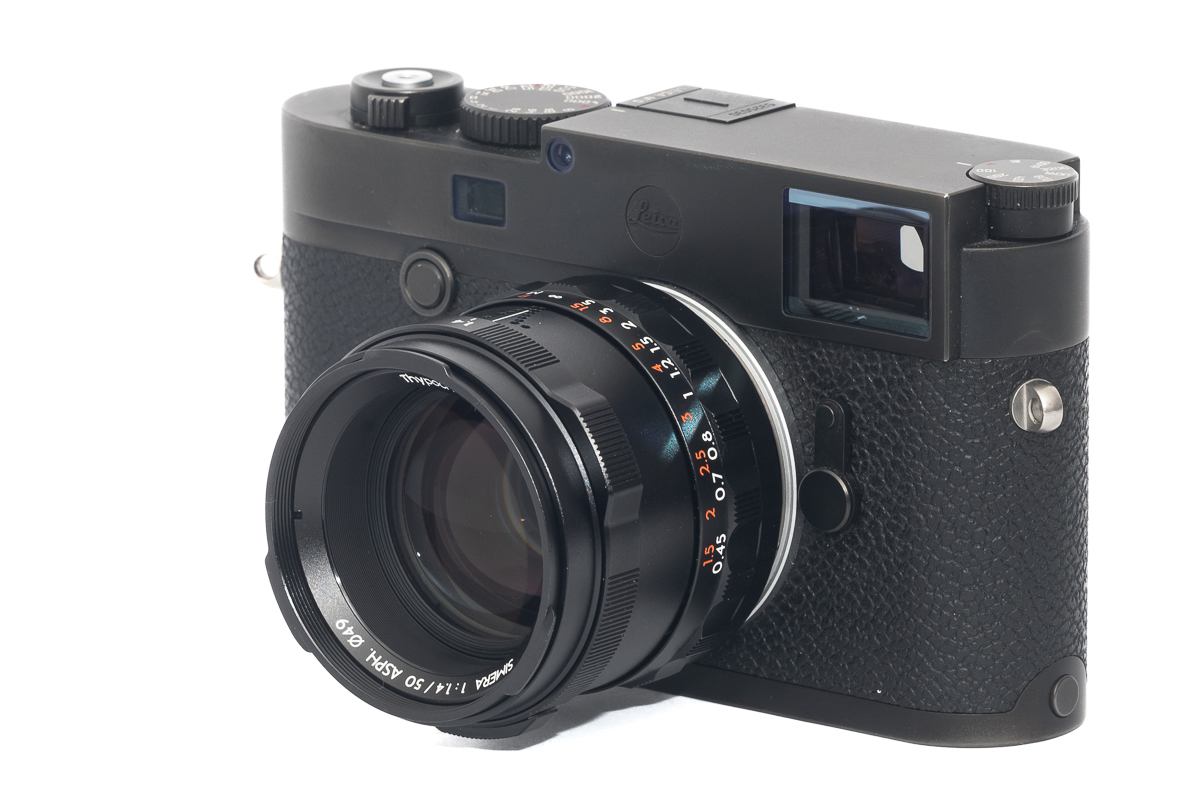

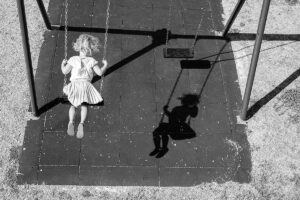


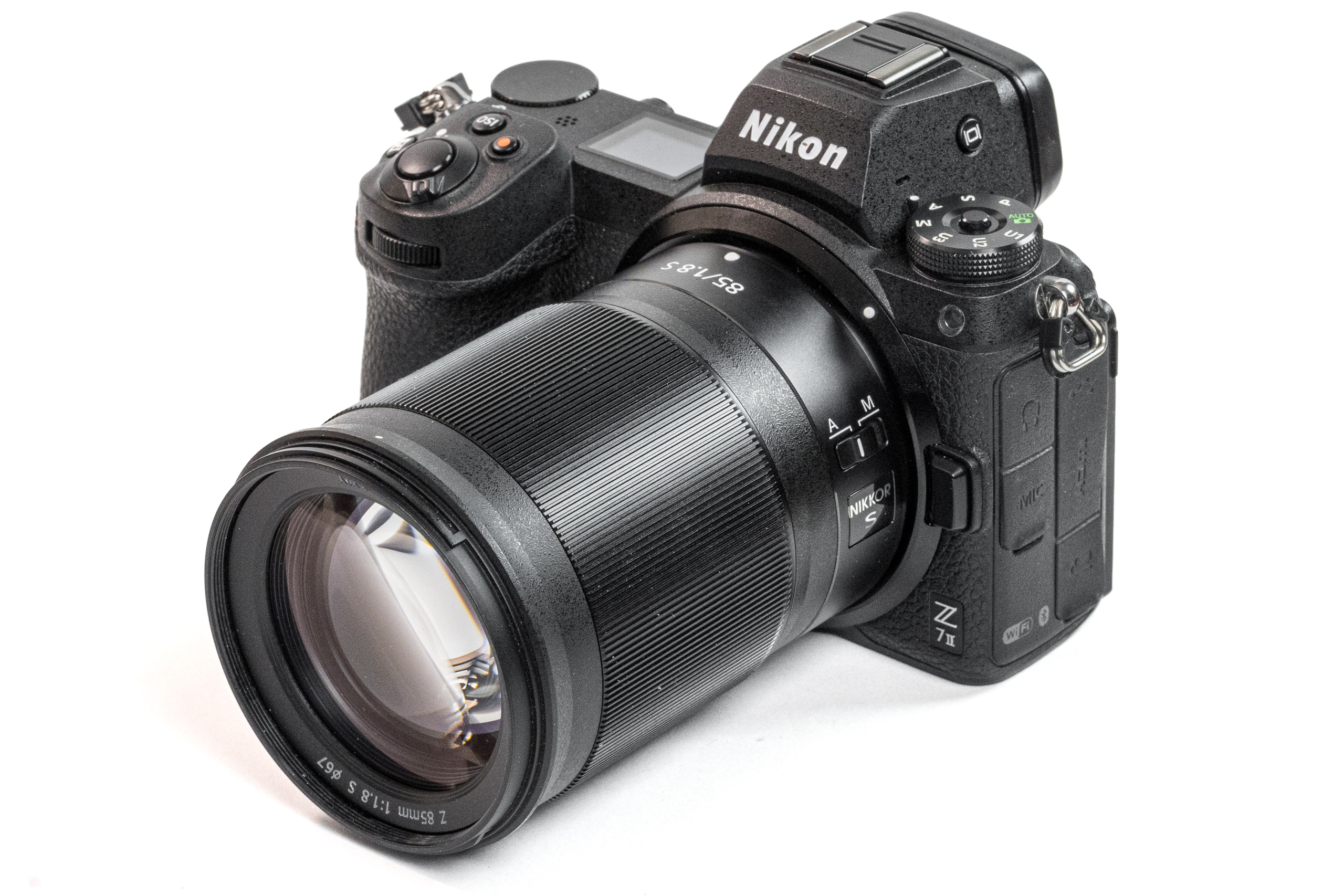

 English (US) ·
English (US) ·